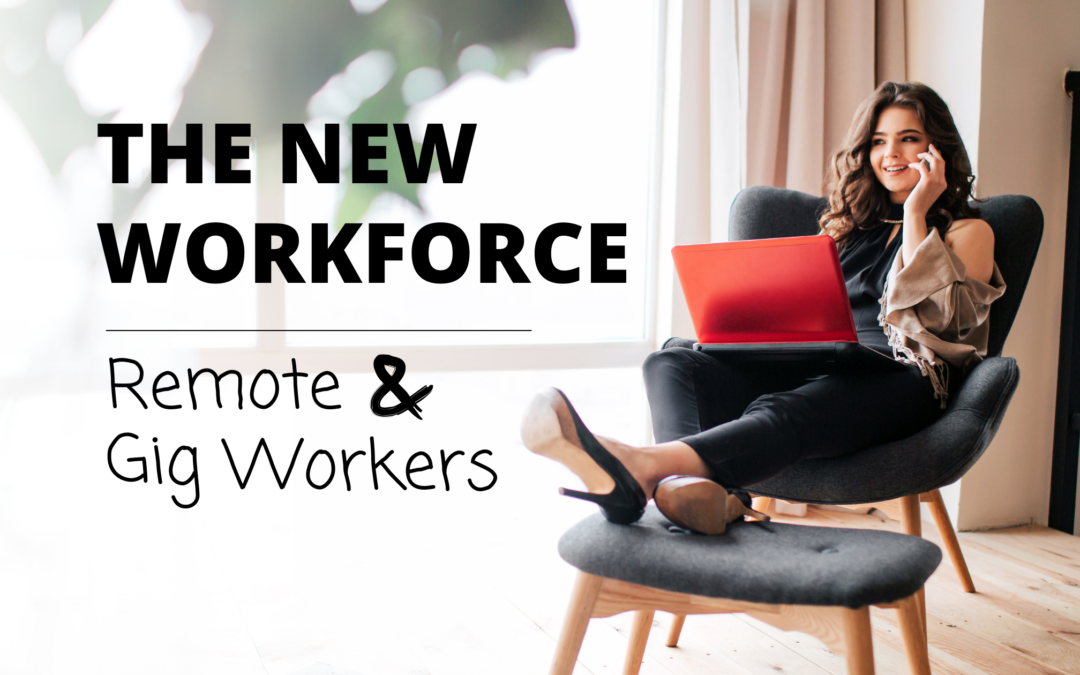Despite, a dramatic shift in employment due to bulk resignations and pandemic-related layoffs, several employers are steadfastly holding to relatively outdated employment policies.
As of December 2021, Pew Research reports that as many as 16 percent of American adults (around 41 million people when looking at the 2020 US Census) have earned money through gig work at one point or another.
Another Pew Research report, this one from November 2021, accounts for about 16 million self-employed persons. What both of these numbers show us is that millions of people are actively seeking income streams that allow them to control their work environment and hours.
Gig Workers
Gig workers are people who earn money outside of the standard 9 to 5 type job, shaking off employee contracts and rigid work structures. Their income is essentially per “gig” or job that they complete. Well-known employers of gig workers are Uber, TaskRabbit, and DoorDash
Contract and project-based workers are some of the most common gig workers today and we can see why. As employee expectations change and some employers remain stuck in tradition, it seems much more logical for some to contract out their skills and set their own terms for their services.
While employers may be hesitant to work with contractors because they can’t direct and lead the relationship like they can with an employee, contractors offer businesses the ability to work with a very specific skill set for only the duration they need. This cuts out the cost of training, time commitment from a direct supervisor, and even the cost for needed equipment or programs.
Remote Workers
We can be sure that, after the mayhem of sudden lockdown and the abrupt shift into hyper-digitalization, remote work is here to stay.
Employees like the flexibility of working wherever they like, controlling their pace and environment, and the fact that their pets are now their primary office mates.

A recent study shows that around 57 percent of employees who have returned to the office would prefer working at home full-time, despite 78 percent feeling more included.
According to Owl Labs, of the people who changed jobs, 84% sought more flexibility in where they work and 82% sought more flexibility in when they work.
What Hybrid Looks Like
Some leaders have gasped at the idea of a hybrid workplace while others are steamrolling ahead with it and to great success, but what does hybrid really look like?
Hybrid means many things in business and the simplest is that it’s a blending of remote and in-person work environments. This can occur at an individual level where specific employees work in the office part-time and at home part-time. It also is more frequently adopted at the company level where a business consists of a mix of team members who work remotely, in person, and hybrid.
The pandemic forced more and more companies to adopt fully-remote or hybrid work models. According to the Owl Labs 2021 State of Remote Work report, office spaces are starting to become primarily for collaboration as only 36 percent of team members think the office is best suited for individual work.
With the realization that it’s possible, and often more efficient, to meet employees in the spaces they work best in, more and more people expect flexibility within their company.
Time to Adapt

With all of this knowledge about the new workforce at our fingertips and team members taking to social media to tell everyone exactly what they want, it’s time to adapt.
Changing the way you employ people means changing the way you do business, which can seem like a daunting prospect at first.
Here are some things to implement to adapt to the new workforce:
- Used cloud-based software programs. For things like CRMs, phone systems, or internal chat forums, there is a multitude of great options. Updated systems will be cloud-based already making it easier and more efficient to share and store information.
- Post your jobs as either remote, in-person, or hybrid to clarify the job parameters before someone applies.
- Contract out non-central tasks where you can. You’ll still provide someone income, but it will likely be more cost-effective and even efficient for your team to contract out those responsibilities that aren’t central to your business’s mission.
- Be transparent about the workload, job expectations, and full compensation packages. Applicants are also screening your job descriptions and interviewing your recruiters to determine a fit. The less information you provide, the fewer quality hires you’re likely to be able to make.
Software that Supports Your Efforts
Forget the notion that software is some complex entity that you need a degree to dance with. Nearly every business in existence today utilizes some type of software to aid daily tasks.
In fact, in an article for Confluent, Jay Kreps even goes so far as to describe how ingrained and affluent software is by saying that “Every company is becoming software.”
Whether you’re on board with this sweeping statement or not isn’t important. Kreps makes several key points as he walks through how deeply software is now worked into processes and the core functions of the business.
In order to keep up with the modern workforce, you have to keep up with modern technology and that means finding efficient software solutions to keep operations going no matter where or when your team members are working. You’ll also want to make sure that collaborating with people outside of your organization is not only possible but easy.

For example, did you know that your office phone system can be just as mobile as your team? No, you don’t need to buy everyone a cell phone.
VoIP technology makes it possible to access your office phone from a landline, desktop, or mobile app so long as you can connect to the internet. It also streamlines multiple forms of communication into one channel including calling, texting, virtual fax, conferencing, and an internal chat feature.
A shameless plug; Aline Phone Systems does all of this at an affordable price with free support from our own team. We don’t outsource your questions, problems, and concerns. Instead, we work with you to find the best solution for your needs.
Aline is a cloud-based, VoIP phone system that makes your business more efficient and easier to manage. Click here for a free quote from Aline!


Good luck.